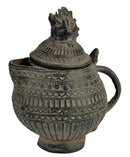In this tribal art sculpture of Jungle kettle, a tribal life gets reflected in the simplest manner.There are some nice floral designs inscribed on it. The Jungle Kettle has more utilitarian value than artistic one for the tribal people. The kettle has been cast in the traditional Dhokra art format, one of India's most ancient art forms. Here the cover of the kettle is crafted in the mould of an animal. Numerous images are cast in the dhokra tradition as artisans preserve their ancient culture, custom and belief through the wondrous pieces they create. Dhokra metal casting uses lost wax method that was probably used by the Mohenjodaro craftsmen to cast the Bronze figurine of the Dancing girl around 4500 years ago.
Description
In this tribal art sculpture of Jungle kettle, a tribal life gets reflected in the simplest manner.There are some nice floral designs inscribed on it. The Jungle Kettle has more utilitarian value than artistic one for the tribal people. The kettle has been cast in the traditional Dhokra art format, one of India's most ancient art forms. Here the cover of the kettle is crafted in the mould of an animal. Numerous images are cast in the dhokra tradition as artisans preserve their ancient culture, custom and belief through the wondrous pieces they create. Dhokra metal casting uses lost wax method that was probably used by the Mohenjodaro craftsmen to cast the Bronze figurine of the Dancing girl around 4500 years ago.
Payment & Security
Your payment information is processed securely. We do not store credit card details nor have access to your credit card information.


